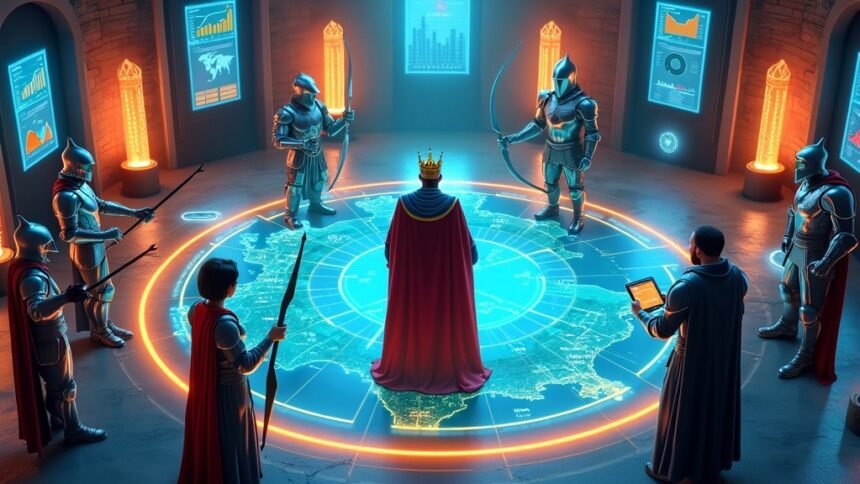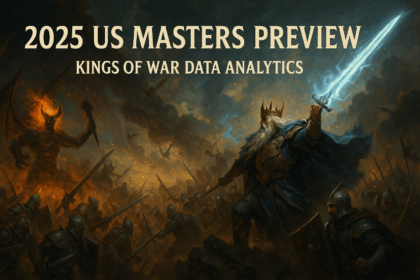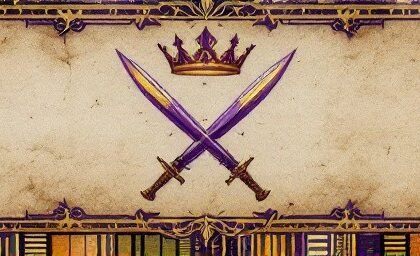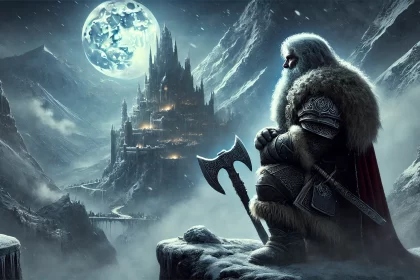As a passionate Kings of War player and a data enthusiast, I’m always looking for new angles to explore and confirm (or contradict) common wisdom. Recently I wanted to dig into army archetypes, popularized by Death by Dragon’s Army Primers. I wanted to uncover the underlying patterns that define how armies are built and how they perform against each other on the battlefield. After meticulous data collection and analysis, I identified six distinct army archetypes through a comprehensive clustering process. In this blog post, I’ll share some findings and thoughts.
The Analytical Journey: From Data to Clusters
Data Collection
I gathered army lists from multiple tournaments (including 2024 US Masters, 2024 LoneWolf GT, 2024 Aussie CoK, and 2024 UK CoK, among others), focusing on player-specific factors rather than player performance. This approach ensured that the analysis was based solely on the intrinsic qualities of the armies themselves.
Key Factors Analyzed
To accurately cluster the armies, I considered a wide range of variables that define an army’s strategic capabilities:
- Speed and Mobility: Average Speed, Number of Nimble Units, Number of Shambling Units
- Resilience and Survivability: Average Defense, Nerve Pool, Shots to Six Nerve, Regeneration, Lifeleech
- Healing and Recovery: Total Heal Capabilities, Presence of Iron Resolve
- Offensive Output: Total Melee Attacks, Total Ranged Attacks, Expected Damage Output
- Unit Composition: Total Number of Units, Unit Strength, Number of Scoring Units
- Special Abilities: Presence of Stealthy Units, Shock Troops, Anvils, Buffers
By quantifying these factors for each army list, I created a comprehensive dataset over more than 1,000 games that reflects the multifaceted nature of army compositions in Kings of War.
Clustering Methodology
I employed K-Means Clustering, a popular machine learning algorithm, to group the armies based on the similarities in their attributes. After experimenting with different numbers of clusters, I found that six clusters provided the most meaningful separation of army archetypes. The K-Means algorithm works by:
- Initialization: Selecting six random centroids (mean points) in the multidimensional space defined by the factors above.
- Assignment: Assigning each army to the nearest centroid based on Euclidean distance.
- Update: Recalculating the centroids as the mean of all armies assigned to that cluster.
- Iteration: Repeating the assignment and update steps until the centroids no longer change significantly.
This process resulted in six distinct clusters, each representing a unique army archetype. Note that the percentage breakdowns of army frequency aren’t adjusted for the frequency with which the list is played. E.g., while Varangur is generally considered an alpha strike army, there aren’t many Varangur lists out there, while there are a lot of Northern Alliance lists, so Northern Alliance is dramatically more represented. Consider this analysis a consideration of the types of lists you’re likely to see in actual play, not theoretical archetypes that could be made.
Introducing the Six Army Archetypes
Cluster 0: Alpha Strike
- Percentage of Armies: 22.4%
- Dominant Factions:
- Twilight Kin: 19.8%
- Northern Alliance: 14.5%
- Forces of the Abyss: 11.7%
- Average Stats:
- Average Speed: 7.20
- Nimble Units: 5.03
- Total Melee Attacks: 152.8
- Expected Damage: 65.0
- Average Defense: 4.11
- Nerve Pool: 204.1
- Total Ranged Attacks: 26.6
- Regeneration: 2.30
- Heal: 4.50
Description:
Alpha Strike armies are built for speed and aggression. With an average speed of 7.20 and over 5 nimble units per army, these forces excel at rapid engagement and flanking maneuvers. The high total melee attacks (152.8) and expected damage output (65.0) indicate their focus on delivering devastating blows early in the game. In other words, their mantra is hit first, hit hard.
Faction Insights:
- Twilight Kin (19.8%): Their inclusion reflects their access to fast and hard-hitting units across a variety of unit types.
- Northern Alliance (14.5%): They bring excellent chaff (snow foxes) to complement powerful hammers like the Frostfangs.
- Forces of the Abyss (11.7%): Units like Abyssal Horsemen and Molochs contribute to the high offensive output.
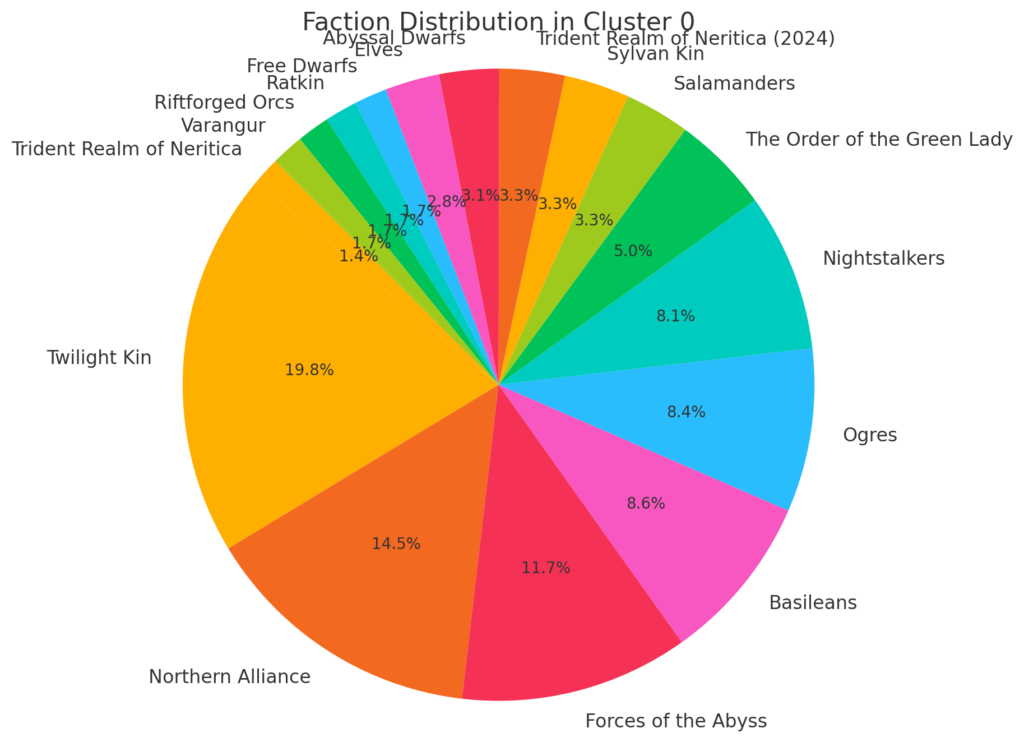
Cluster 1: Gun Line
- Percentage of Armies: 15.5%
- Dominant Factions:
- Dwarfs: 86.0%
- Abyssal Dwarfs: 9.3%
- Free Dwarfs: 4.7%
- Average Stats:
- Average Speed: 4.78
- Total Ranged Attacks: 43.6 (Highest among clusters)
- Average Defense: 5.15 (Highest among clusters)
- Nerve Pool: 229.5
- Total Melee Attacks: 120.2
- Expected Damage: 63.3
- Heal: 0.42
- Lifeleech: 0.91
Description:
Gun Line armies prioritize ranged combat and defensive resilience. With the highest average defense (5.15) and the highest total ranged attacks (43.6), they are designed to control the battlefield from a distance. Their lower average speed (4.78) reflects a static playstyle, relying on their firepower to weaken or eliminate threats before they can engage in close combat.
Faction Insights:
- Dwarfs (86.0%): Their dominance is due to units like Sharpshooters, which provide substantial ranged attacks.
- Abyssal Dwarfs (9.3%): Contribute with Decimators and Katsuchan Rocket Launchers.
- Free Dwarfs (4.7%): Add variety with units like Ranger Regiments.

Cluster 2: Grind
- Percentage of Armies: 10.5%
- Dominant Factions:
- Empire of Dust: 30.3%
- Forces of Nature: 13.8%
- Halflings: 11.8%
- Average Stats:
- Average Speed: 6.44
- Heal: 6.77 (Highest among clusters)
- Lifeleech: 4.91 (Highest among clusters)
- Nerve Pool: 226.1
- Average Defense: 4.60
- Total Melee Attacks: 132.7
- Expected Damage: 57.8
- Regeneration: 1.38
Description:
Grind armies are designed for endurance and attrition warfare. With the highest heal (6.77) and lifeleech (4.91) values, they can sustain prolonged engagements, slowly wearing down the enemy. Their decent average speed (6.44) allows them to position effectively, and their substantial nerve pool (226.1) enhances their survivability.
Faction Insights:
- Empire of Dust (30.3%): Utilize units like Revenant Hordes and Enslaved Guardians with access to Surge and healing spells.
- Forces of Nature (13.8%): Bring in Elementals and Forest Shamblers, benefiting from Regeneration and healing.
- Halflings (11.8%): Contribute with their Iron Beast units and support casters.
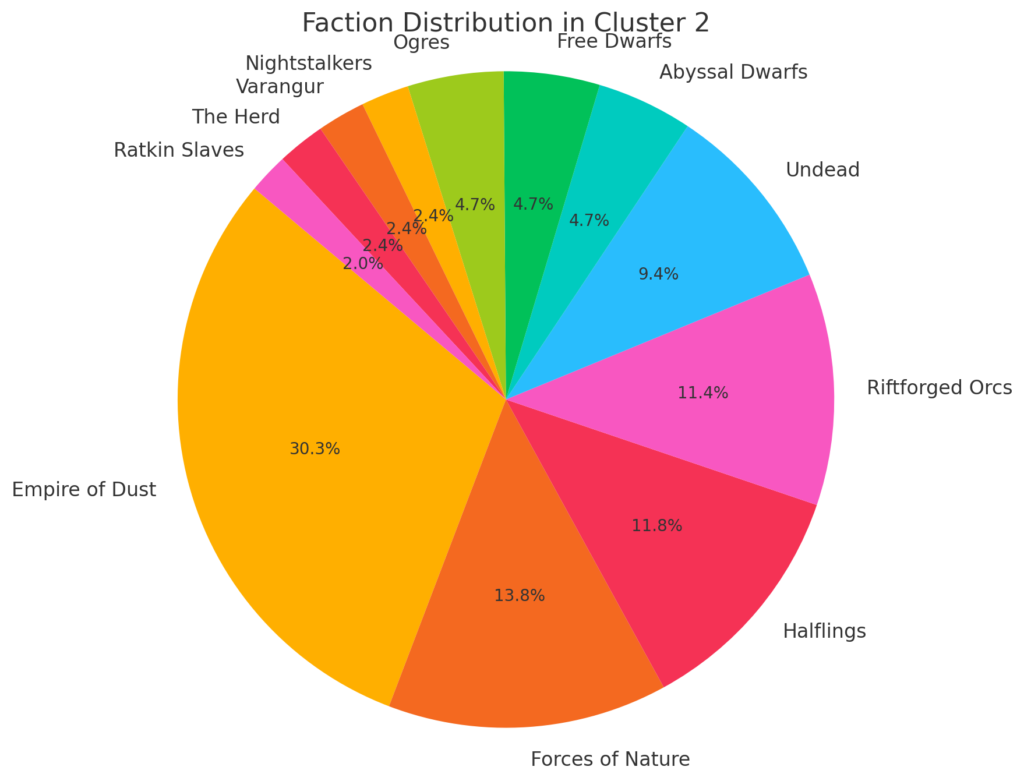
Cluster 3: Trash
- Percentage of Armies: 13.0%
- Dominant Factions:
- Goblins: 46.6%
- Ratkin: 22.1%
- Nightstalkers: 9.2%
- Average Stats:
- Total Units: 17.3 (Highest among clusters)
- Unit Strength: 27.1 (Highest among clusters)
- Total Melee Attacks: 203.5 (Highest among clusters)
- Expected Damage: 67.2 (Highest among clusters)
- Average Speed: 6.42
- Nimble Units: 5.39
- Total Ranged Attacks: 44.1
- Nerve Pool: 225.7
Description:
Trash armies overwhelm opponents with sheer numbers. With the highest total units (17.3) and unit strength (27.1), they flood the battlefield, making it difficult for opponents to target all threats effectively. Their high expected damage (67.2) comes from the volume of attacks rather than individual unit potency. This strategy has been on display at recent US Masters, with both Goblins (Cyle Pool) and Nightstalkers (Adam Ballard, Nathan Clevenger) making strong showings.
Faction Insights:
- Goblins (46.6%): Known for cheap units like Rabble and Sharpsticks, allowing them to field large armies.
- Ratkin (22.1%): Add to the swarm with cheap Warriors.
- Nightstalkers (9.2%): Can anyone say hordes of scarecrows?

Cluster 4: Balanced/Shambling
- Percentage of Armies: 17.3%
- Dominant Factions:
- Undead: 34.9%
- Abyssal Dwarfs: 10.6%
- Halflings: 7.8%
- Average Stats:
- Average Speed: 6.32
- Shambling Units: 3.95
- Heal: 4.94
- Lifeleech: 4.88
- Nerve Pool: 217.9
- Average Defense: 4.59
- Total Melee Attacks: 137.4
- Expected Damage: 63.0
Description:
Balanced/Shambling armies offer versatility, capable of both offensive and defensive strategies. The presence of nearly four shambling units on average allows for tactical flexibility, especially when combined with Surge spells. Their heal and lifeleech values are high, enhancing their sustainability. In some respects, this is similar to the Grind lists but with less healing and defense and more shambling.
Faction Insights:
- Undead (34.9%): Dominant due to units like Zombies, Skeletons, and Wights, leveraging Surge and lifeleech.
- Abyssal Dwarfs (10.6%): Contribute with Lesser Obsidian Golems and Decimators.
- Halflings (7.8%): Add balance with infantry and support units.
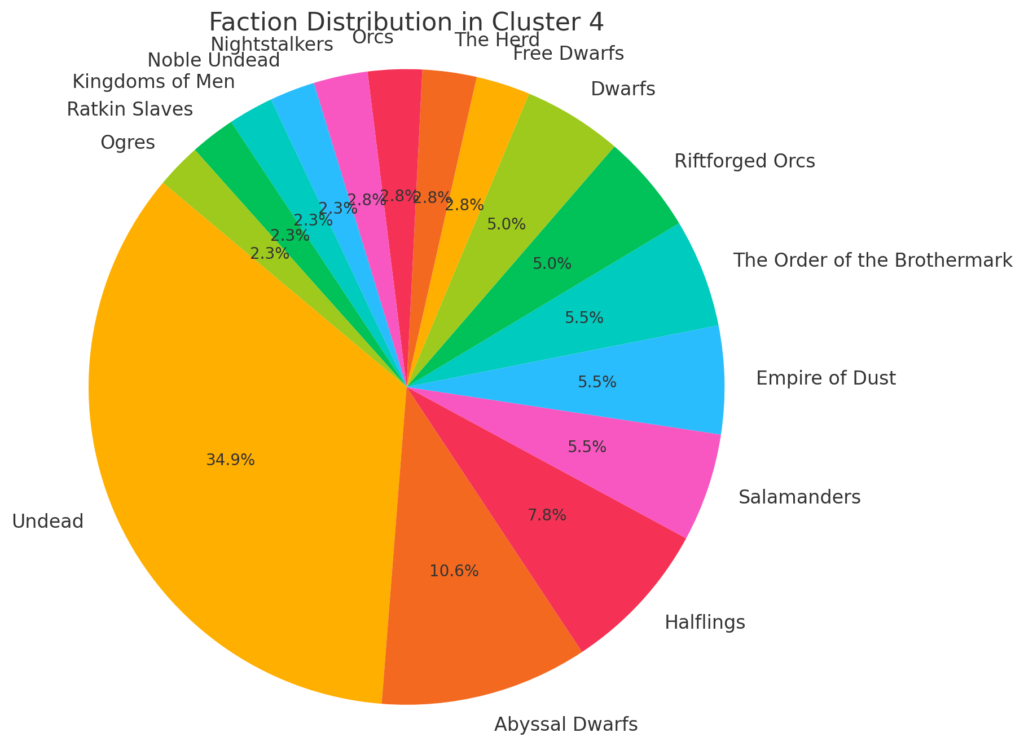
Cluster 5: Balanced/Mobile
- Percentage of Armies: 21.3%
- Dominant Factions:
- Ogres: 17.0%
- Forces of the Abyss: 9.7%
- Northern Alliance: 9.4%
- Average Stats:
- Average Speed: 6.84
- Nimble Units: 4.91
- Total Ranged Attacks: 36.7
- Total Melee Attacks: 132.3
- Expected Damage: 60.9
- Average Defense: 4.28
- Nerve Pool: 214.1
- Heal: 4.85
- Regeneration: 2.09
Description:
Balanced/Mobile armies combine versatility with mobility. With a high average speed (6.84) and nearly five nimble units, they can adapt quickly to battlefield changes. Their balanced offensive stats in both melee and ranged attacks make them flexible in engaging different types of enemies. In many respects, they’re similar to Cluster 4, but with less shambling, more nimble, and more mobility. This is your classic mixed arms list without shambling.
Faction Insights:
- Ogres (17.0%): Lead this cluster with units like Ogre Warriors and Boomers, providing both melee strength and ranged firepower.
- Forces of the Abyss (9.7%): Add mobility with units like Succubi and Tortured Souls.
- Northern Alliance (9.4%): Contribute with versatile units like Ice Naiads and Human Clansmen.
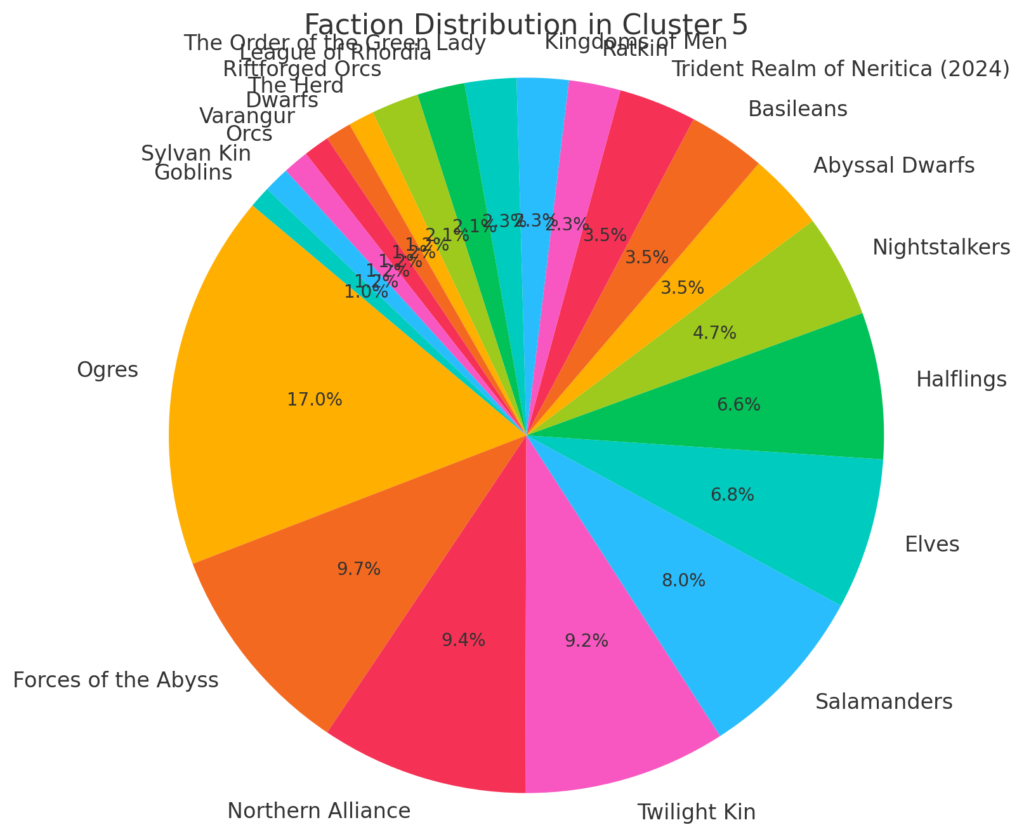
Conclusions and Strategic Insights
Through detailed data analysis, I identified six distinct army archetypes in Kings of War:
- Alpha Strike: Fast and aggressive armies aiming for early dominance.
- Gun Line: Defensive armies that control the battlefield with ranged attacks.
- Grind: Sustainable armies built for endurance and attrition warfare.
- Trash: Armies that overwhelm with sheer numbers and aggressive tactics.
- Balanced/Shambling: Versatile armies leveraging shambling units and tactical flexibility.
- Balanced/Mobile: Adaptable armies combining balance with mobility.
Key Observations:
- Faction Tendencies: Certain factions naturally align with specific archetypes due to their unit options and abilities. For example, Dwarfs dominate the Gun Line archetype, while Goblins are prevalent in the Trash archetype.
- Matchup Dynamics: Understanding how archetypes perform against each other can inform both army list building and in-game tactics. For instance, if you play a Gun Line army, being aware of your vulnerabilities against Grind and Trash armies can help you adjust your strategy.
- Versatility vs. Specialization: Balanced armies offer flexibility but may lack the focused strengths of specialized archetypes. Choosing an archetype that suits your playstyle and mastering its nuances can provide a competitive edge.
Final Thoughts:
This analysis has deepened my appreciation for the strategic depth of Kings of War. By quantifying and examining the attributes of different armies, we can gain valuable insights into the game’s meta and enhance our understanding of how to build and play our armies effectively.
In a future post, I’ll compare how these archetypes perform against each other and give you the actual data from tournaments. Stay tuned for more. Until then–
Happy gaming, and may your strategies lead you to victory!
Note: The data and findings presented here are based on the analysis of tournament army lists available at the time of this study. The meta is always evolving, and future releases or updates may influence faction strengths and archetype dynamics.

